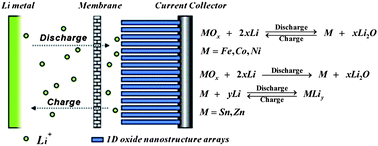Lithium ion battery (LIB) is potentially one of the most attractive energy storage devices. To meet the demands of future high-power and high-energy density requirements in both thin-film microbatteries and conventional batteries, it is challenging to explore novel nanostructured anode materials instead of conventional graphite. Compared to traditional electrodes based on nanostructure powder paste, directly grown ordered nanostructure array electrodes not only simplify the electrode processing, but also offer remarkable advantages such as fast electron transport/collection and ion diffusion, sufficient electrochemical reaction of individual nanostructures, enhanced material–electrolyte contact area and facile accommodation of the strains caused by lithium intercalation and de-intercalation. This article provides a brief overview of the present status in the area of LIB anodes based on one-dimensional nanostructure arrays growing directly on conductive inert metal substrates, with particular attention to metal oxides synthesized by an anodized alumina membrane (AAM)-free solution-based or hydrothermal methods. Both the scientific developments and the techniques and challenges are critically analyzed.

You have access to this article
 Please wait while we load your content...
Something went wrong. Try again?
Please wait while we load your content...
Something went wrong. Try again?


 Please wait while we load your content...
Please wait while we load your content...